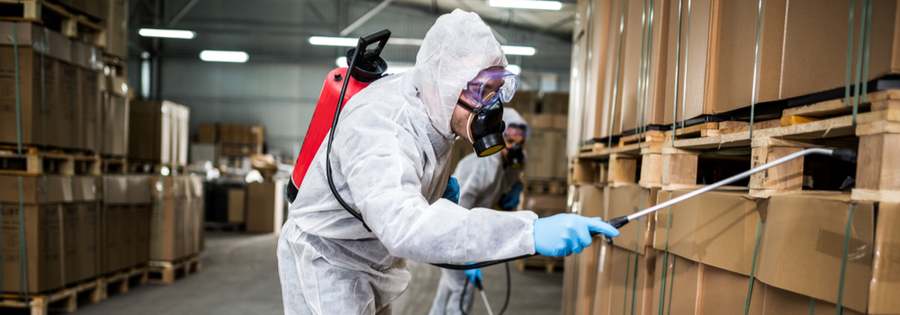A Comprehensive Overview to the Various Kinds Of Bug Control Approaches
With the myriad of insect control techniques offered, it can be frustrating to find the most efficient service for a particular parasite issue. In this extensive guide, we will certainly discover these various kinds of pest control techniques, providing understandings right into their applications and advantages. By the end, you will certainly have a clearer understanding of which method may be the ideal fit for your pest control requirements.
Chemical Bug Control Methods

One common kind of chemical pest control is pesticides. Insecticides target certain insects, such as insects, termites, or ants, and can be made use of both indoors and outdoors.
Another kind of chemical insect control is rodenticides. These are chemical compounds made to manage populations of rodents, such as rats and mice.
Weed killers, likewise called herbicides, are one more kind of chemical parasite control approach. Herbicides are made to uniquely kill unwanted plants, understood as weeds, without creating damage to preferable plants. They are frequently utilized in farming, landscaping, and gardening to manage the development of undesirable greenery.
While chemical pest control methods can be highly effective in getting rid of insects, it is essential to use them sensibly and follow safety and security guidelines. Overuse or abuse of chemical pesticides can have adverse influence on human wellness and the atmosphere. Consequently, it is essential to use these methods responsibly and take into consideration different pest control techniques whenever possible.
Biological Insect Control Methods
Biological parasite control approaches entail making use of living microorganisms or all-natural substances to handle and manage pest populations. Unlike chemical approaches, which frequently count on synthetic chemicals, organic control methods utilize the natural enemies of pests to regulate their populaces. This method is taken into consideration more eco friendly and lasting, as it lowers making use of unsafe chemicals and reduces the risk of chemical resistance.
One extensively used biological bug control approach is the introduction of all-natural killers or bloodsuckers. Ladybugs are presented to regulate aphids, while certain wasp species are released to target caterpillars. These killers and bloodsuckers eat parasites, minimizing their numbers and preventing infestations.
One more biological control technique is making use of microorganisms. Certain germs, viruses, and fungi can be employed to infect and kill certain pests. For instance, the microorganism Bacillus thuringiensis is commonly used to control caterpillars, as it creates toxic substances that are deadly to these bugs.
Organic control methods can also entail making use of pheromones or natural substances that interfere with the breeding patterns of bugs. By interfering with their reproduction, these approaches help to reduce pest populations over time.
While organic insect control methods are typically efficient, they may call for longer periods to attain preferred results compared to chemical approaches. In addition, moth control cautious consideration has to be offered to the option and release of all-natural opponents to stop unintended harm to useful microorganisms or ecological communities.
Physical Insect Control Methods
To successfully manage and control pest populaces, alternate insect control approaches understood as physical insect control methods are used. One more physical pest control approach is the setup of fences or wall surfaces to keep bigger bugs, such as deer or rabbits, out of gardens or farming fields. Physical pest control approaches are an ecologically friendly alternative to chemical pesticides, as they do not rely on the use of unsafe chemicals.
Natural Insect Control Approaches
Natural bug control techniques supply a lasting and green technique to handling and eliminating bugs. These approaches focus on making use of natural compounds and organic agents, minimizing the demand for chemical pesticides that can damage the atmosphere and human health. Among the most common all-natural pest control techniques is biological control. This entails presenting all-natural predators or check this site out bloodsuckers to prey on or parasitize the insects. Ladybugs are commonly presented to gardens to control aphid populaces. An additional natural technique is the use of repellents originated from plants. Certain plants, such as marigolds, lavender, and peppermint, release aromas that drive away parasites like mosquitoes, flies, and ants. In addition, cultural control practices can be used to avoid and take care of pest problems. This consists of appropriate hygiene, normal upkeep, and advertising biodiversity in the garden. Revolving plants, eliminating garden debris, and motivating all-natural killers can aid stop the accumulation of bugs. By adopting these all-natural insect control pestcon methods, people and neighborhoods can successfully take care of insects while lessening the unfavorable impacts on the environment and human health.
Integrated Pest Monitoring (IPM)
Integrated Bug Monitoring (IPM) is a thorough and methodical approach to pest control that incorporates various techniques and strategies to properly manage pests while reducing the use of chemical pesticides. IPM aims to preserve parasite populaces listed below the financial injury degree by making use of a mix of cultural, biological, and chemical control techniques.
Cultural control techniques include changing the environment to make it less favorable for pests. This can include practices such as crop rotation, appropriate cleanliness, and the usage of resistant plant ranges. By creating unfavorable conditions for pests, cultural control approaches can significantly reduce insect populations.

Chemical control techniques are made use of as a last option in IPM. They entail the targeted and judicious use chemicals to manage insect populaces. Unlike traditional insect control techniques, IPM intends to minimize making use of chemical pesticides by utilizing different strategies.
Integrated Bug Monitoring (IPM) is an aggressive approach that concentrates on long-lasting parasite administration instead than counting only on reactive steps. By incorporating several control techniques, IPM gives a more sustainable and eco-friendly strategy to pest control.
Final Thought
It reviewed chemical, organic, physical, and all-natural pest control approaches, as well as the integrated pest management approach. By recognizing these different methods, people can make informed choices on which parasite control method is most appropriate for their specific requirements and preferences.